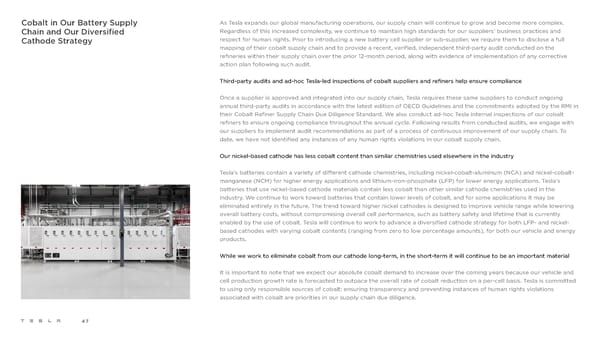Cobalt in Our Battery Supply As Tesla expands our global manufacturing operations, our supply chain will continue to grow and become more complex. Chain and Our Diversified Regardless of this increased complexity, we continue to maintain high standards for our suppliers’ business practices and Cathode Strategy respect for human rights. Prior to introducing a new battery cell supplier or sub-supplier, we require them to disclose a full mapping of their cobalt supply chain and to provide a recent, verified, independent third-party audit conducted on the refineries within their supply chain over the prior 12-month period, along with evidence of implementation of any corrective action plan following such audit. Third-party audits and ad-hoc Tesla-led inspections of cobalt suppliers and refiners help ensure compliance Once a supplier is approved and integrated into our supply chain, Tesla requires these same suppliers to conduct ongoing annual third-party audits in accordance with the latest edition of OECD Guidelines and the commitments adopted by the RMI in their Cobalt Refiner Supply Chain Due Diligence Standard. We also conduct ad-hoc Tesla internal inspections of our cobalt refiners to ensure ongoing compliance throughout the annual cycle. Following results from conducted audits, we engage with our suppliers to implement audit recommendations as part of a process of continuous improvement of our supply chain. To date, we have not identified any instances of any human rights violations in our cobalt supply chain. Our nickel-based cathode has less cobalt content than similar chemistries used elsewhere in the industry Tesla’s batteries contain a variety of different cathode chemistries, including nickel-cobalt-aluminum (NCA) and nickel-cobalt- manganese (NCM) for higher energy applications and lithium-iron-phosphate (LFP) for lower energy applications. Tesla’s batteries that use nickel-based cathode materials contain less cobalt than other similar cathode chemistries used in the industry. We continue to work toward batteries that contain lower levels of cobalt, and for some applications it may be eliminated entirely in the future. The trend toward higher nickel cathodes is designed to improve vehicle range while lowering overall battery costs, without compromising overall cell performance, such as battery safety and lifetime that is currently enabled by the use of cobalt. Tesla will continue to work to advance a diversified cathode strategy for both LFP- and nickel- based cathodes with varying cobalt contents (ranging from zero to low percentage amounts), for both our vehicle and energy products. While we work to eliminate cobalt from our cathode long-term, in the short-term it will continue to be an important material It is important to note that we expect our absolute cobalt demand to increase over the coming years because our vehicle and cell production growth rate is forecasted to outpace the overall rate of cobalt reduction on a per-cell basis. Tesla is committed to using only responsible sources of cobalt; ensuring transparency and preventing instances of human rights violations associated with cobalt are priorities in our supply chain due diligence. 47
 Tesla Impact Report 2020 Page 46 Page 48
Tesla Impact Report 2020 Page 46 Page 48